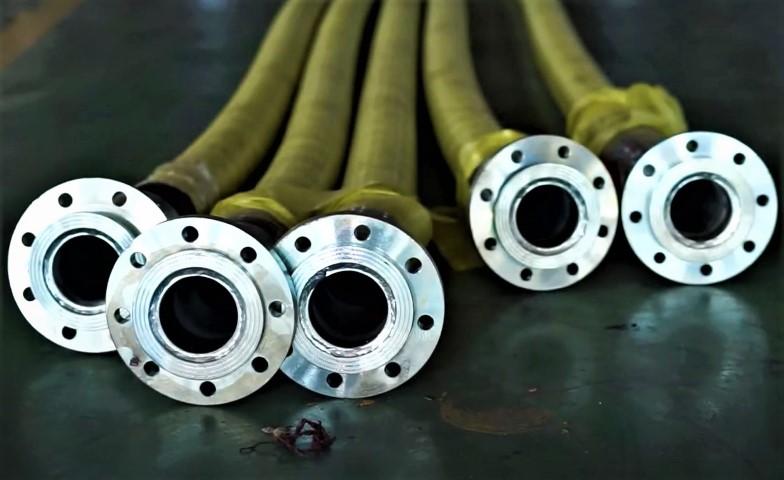Concrete Pump Hose Pipe Flanges
2023-07-05 10:46:28
Concrete pump hoses require relatively high pressures to move the concrete from the concrete machine and to the place of discharging. Often the boom-type applications experience pulsating output which may increase the pressures significantly or cause a negative pressure condition within the flexible hose causing it to collapse.
The present invention relates to a coupling unit for interconnecting a hose end with a rigid pipe end, such as those used on Putzmeister and Schwing type concrete pumps. The coupling includes an inner hard metal shank and an outer soft metal ferrule especially deformed on the hose to form a firm physical clamping.
End Fittings
A recent safety alert from Workplace Health & Safety Queensland highlighted the risk of concrete pump delivery pipeline hose end fittings failing. It said that a business that fits hose end fittings should follow sound engineering practices and provide documented information on inspection methods to their customers.
Generally, a hose end fitting is attached to the hose by either crimping or swaging the ferrule of the fitting. A crimped hose end fitting can be identified with obvious indentations on the outside part (refer Photograph 5). A swaged hose end fitting does not have the same external marking.
Some hose manufacturers will only guarantee their hoses for specific working pressures when high quality swagged or crimped hose end fittings are fitted. Documented verification of the method used to attach an end fitting to a hose is therefore important, and can be achieved through the use of testing methods such as proof tests or destructive testing on test samples.
Flanges
Flanges help provide a solid connection between the hose and the end fitting. They prevent leaking when pressure is applied to the hose. They also help ensure that the end of the hose is not crushed or pulled out of its fitting. Flanges can be fitted with puddle flanges or captive flange fittings, depending on the specific type of hose.
A wire braid steam hose designed to handle saturated and superheated steam up to 250 psi. It has a pin-pricked cover that allows venting to eliminate air blisters and cover separation. It can be used for portable or production line welding. It also has a copper static wire to prevent electrical charge build-up.
An economical general service suction and discharge hose. It is ideal for transferring water, light chemical solutions and abrasive materials. The helix serves as a scuff strip and it can be rolled up for storage. It is often used with boom trucks.
Hose Ends
When a construction job depends on big supplies of concrete, you can’t afford to have your pump fail in the middle. That’s why concrete pump hoses are made to be as rugged and long-lasting as the concrete being delivered.
Conventional couplings on flexible conduits or hoses include an inner shank of relatively hard metal with its outer surface serrated or otherwise configured to engage a soft metal ferrule specially deformed onto the hose to form firm physical clamping of the hose to the shank. This arrangement is augmented by the provision of a ductile metal ring that forms a second flange in contact with the shank to enhance and bolster the flange and hose coupling. The hose coupling may be further strengthened by the provision of an inner helically wound wire support within the ductile metal ferrule. A method for affixing the end coupling to the hose includes abrading the outer hose surface adjacent the coupling end to expose the helically wound wire support and passing a current through it to heat treat the supporting wire to permit outward expansion thereof to affix the end coupling to the helically wound wire support in a simple and economical manner.
Hose Body
The hose body is a rubber base which has the usual strengthening fabric embedded within it. In the present invention, a hardened wire support or coil unit 26 is also embedded within the hose body 24 at a position adjacent the end coupling portion of the hose.
The end coupling of the hose has an outer surface serrated or otherwise adapted for firm interengagement with the inner hose surface grooved for interconnection by the conventional quick release coupler. Unlike prior constructions, the end coupling is not provided with an inner soft metal shank for outward expansion to form firm physical clamping of the hose to the end coupling.
This enables the hose to withstand the typical negative pressure conditions and bending which are encountered in boom-type applications and the like without collapse of the flexible hose. The hose is also able to withstand high pumping pressures of up to 1,000 pounds per square inch. Warning: When the concrete pump is restarted, the air trapped in the hose line can be released suddenly, as a result of which you should never position any part of your body between the discharge end of the hose and fixed objects like wall forms or walls.